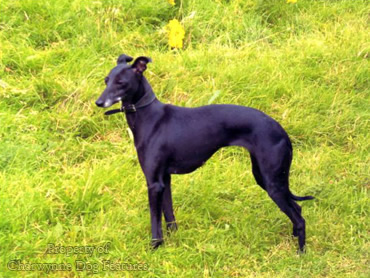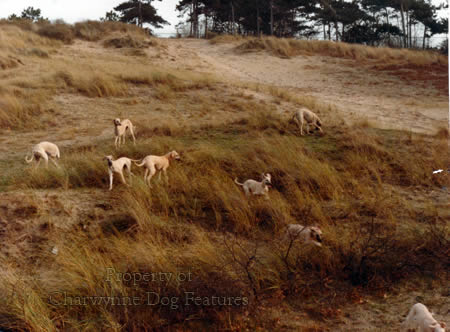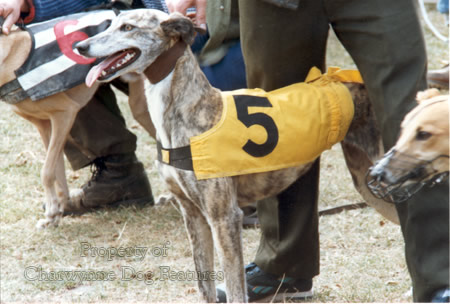763 SIGHTHOUNDS FOR SPORT
SIGHTHOUNDS FOR SPORT
by David Hancock
 The Need to Run
The Need to Run
The sighthound breeds came to us from the sporting field, from being used as coursing hounds; they will only stay with us as real sighthounds if we retain a sporting use for them, whether it’s on the track or on the lure. We owe a great deal to those coursers who bequeathed such remarkable hounds to us; we will only honour their memory by using them. The very expression ‘companion dog’ hints at the dog being there for our benefit but to regard a sighthound purely as a pet is to insult its distinguished heritage; we really must use them. I think it is fair to claim that coursing shaped the sighthound of today into a formidable canine athlete. To maintain the sighthound’s long line of providing excellence is going to prove a challenge. Lure racing is valuable exercise; track racing tests sheer speed and bend handling skills but coursing was the supreme test. All sighthounds need to run!
Coursing Prowess
“The aim of the true sportsman with hounds is not to take the hare, but to engage her in a racing contest or duel, and he is pleased if she happens to escape.”
Arrianus Flavius AD 150.
Those words, from two millennia ago, capture immediately the ethos of coursing across the centuries: it never has been about two hounds striving to catch a hare but a brace of sighthounds striving to outrun each other. The quarry is respected, allowed a fair start or law, and unlike shooting or fox-hunting, permitted to escape at any stage during the chase. In his An Encyclopaedia of Rural Sports of 1870, Delabere Blaine wrote: “The practice of modern coursing may be dated from the time of Elizabeth. Under her auspices it became a fashionable pursuit; nor has time diminished the hold it took on the regards of the sporting public. To further, methodise, and give stability to its practice, a code of laws was framed by the Duke of Norfolk, himself a lover of the leash, that became the stock on which the rules observed at coursing meetings were ingrafted.” Another Norfolk landowner Lord Orford started a line of coursing Greyhounds of remarkable prowess.
Coursing Stars
Orford’s Czarina won 47 matches without ever being beaten; when Orford died, she went, with her co-star son Claret, to the Yorkshire kennel of Colonel Thornton. Claret was put to a high quality bitch owned by another Yorkshire coursing man, Major Topham, to produce three of the best Greyhounds ever seen: Snowball, Major and Sylvia. All three won every match for which they were entered. Snowball was considered to be the finest Greyhound ever bred; he won in every type of country, was famed for his stamina and for his sheer power when running uphill. This blend of Yorkshire and Norfolk blood started perhaps the best ever line of coursing Greyhounds from England and provided the breeding basis for the breed from then on. Snowball sired nearly fifty litters, with the bitches coming from all over Britain. Forty years after Snowball’s whelping, the ‘Blue Riband of the Leash’, the Waterloo Cup, was held at Altcar and from then on, this cup was the pinnacle of coursing fame. It was run on ground where the hare was protected and almost revered.
Winning Colours
Coursing Greyhounds like Czarina, Claret, Major and Snowball, then, later, Fullerton and Master M’Grath, became the sporting icons of their time. Rawdon Lee, the prolific Victorian canine chronicler used depictions of Fullerton and Master M’Grath to illustrate the Greyhound as a breed in his several volumed Modern Dogs series of the late 1890s and early 1900s. But in the text, surprisingly for him, he describes Snowball as a white dog, perhaps confused by the name itself. He could not have seen Chalon’s celebrated painting of Snowball, showing very clearly the shining black coat. Black Greyhounds have been noticeably successful in the coursing fields; In 1830, an analysis of one year’s coursing results showed that blacks or black/whites won 617 prizes against 318 by reds, fawns, and fawn/whites. Blues and blue/whites came next with 134 wins. For me, the most perfect Greyhound in conformation was the stunning black racing Greyhound star Westmead Poncho of thirty years ago. 
Track Racing
Out of coursing came the urban equivalent, track racing. As long ago as 1876, mechanical lure racing was conducted, at first as a spectacle at a sporting show, when two Greyhounds pursued an artificial hare raced along a groove in the track, over a 400 yard grass track. The first race was won by Charming Nell, owned by Edward Dent, breeder of the famous coursing Greyhound Fullerton. But it was interest in America which spread back to Britain, so that from the mid 1920s this new sport took off. In 1926 the average crowd at a track meeting was 11,000. By 1932, the attendances had reached 20 million. With big money now accruing from the sport, the tricksters soon moved in, with doping scandals rife. The National Greyhound Racing Club has worked hard to drive out match-fixing and dog-faking. Bend racing does still have its critics due to the stress placed on the limbs of the racing dog.
Racing the Sighthound Breeds
In a recent report on an Afghan Hound race meeting at Ellesmere Port, these words were used in the introduction: “Those of you who have never taken your dogs racing – you really do not know what you are missing – find your nearest meeting and go along and see what happens. They – and you! – deserve the fun.” This meeting was attended by 22 Afghan Hounds and 27 others: 4 Lurchers, 4 Pharoah Hounds, 3 Salukis as well as Whippets, Border Collies, Siberian Huskies, even Jack Russells and 5 Border Terriers. In the 260s, the best Afghan time was 22 seconds; in the 440 metre run timings varied between 45 and 55 seconds; with some sub seven-second times in the 100 metres. What fun and yes, the dogs do deserve it! 
Organised Sport
In the wake of the Hunting with Dogs Act, the various coursing clubs for Greyhounds, Salukis and Whippets and the staging of the British single-handed longdog/lurcher coursing championships have been suspended. We are left with admirable organizations like the Working Whippet Club, the Whippet Club Racing Association, the New Lancashire Whippet Racing Club, Afghan Racing (open to all breeds) and a number of lure-racing groups, alongside the highly organized very professional track racing world for Greyhounds, to exercise the sighthounds here. Lure coursing aims to stimulate the hounds’ natural instincts to chase quarry. The ‘lure’, a bag or bunch of plastic bags tied to a line powered by an electric motor, using a system of pulleys to drag the lure along a set course, seems to excite the hounds’ innate desire to chase even such an artificial quarry. But, something is better than nothing, in this crucial need to preserve the sighthound urge. The instinctive desire to pursue, the athleticism needed in the chase and the basic need to exercise speed all require an outlet. Running really quickly by dogs must never become archival. 
Sprinting Prowess
A Greyhound can cover 5/16ths of a mile in 30 seconds. In each decade the feats are repeated: in 1932, Ataxy did 525 yards in 29.56 seconds, and, in 1936, 725 yards in 41.69 seconds. In 1971, Dolores Rocket did the 525 yard course in 28.52 seconds. In 1944, Ballyhennessy Seal set what was then a new world record for 500 yards in 27.64 seconds. The legendary Mick the Miller did the 600 yards in 34.01 seconds in 1930. He was spoken of as combining 'tranquility with trackcraft'. In other words he never wasted energy nervously and used the circuit cleverly. When he died he was found to have a heart weighing 1½ ozs above the normal for a Greyhound of his size. Of course hounds with a comparable build can also achieve great speed; a 32lb Whippet was once recorded as covering 150 yards in 8.6 seconds. At the Whippet Club Racing Association Bend Championships held at Moreton In Marsh five years ago, 130 dogs ran on a horseshoe-shaped 240 yard track in 9 different weight groups, with a fastest time of 14.9 seconds. Until coursing becomes legal once again, what a great way to keep the speedsters tried and tested.
“A Greyhound in tip-top condition should be all fire, animation, and sprightliness; his gaiety, expressed in the sparkle of his eyes and the bounding elasticity of his limbs, should be so refreshing to the beholder as to produce the idea that the excellences of the animal could be carried no further.”
The Courser’s Companion by Thomas Thacker, 1834.